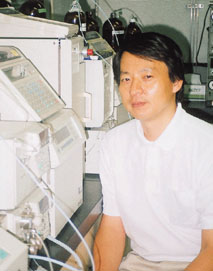| Osamu Negishi |
Ph. D. |
Phytochemistry |

|
|
|
|
|
 |
|
|
Assistant Professor |
|
|
 |
Biosynthesis of secondary metabolites,
caffeine and vanillin, and enzymatic deodorization with polyphenolic compound
(PP) and polyphenol oxidase (PPO) are being studied.
The pathway for caffeine biosynthesis is
xanthosine Æ 7-methylxanthosine Æ 7-methylxanthineÆ theobromine
(3,7-dimethylxanthine) Æ caffeine
(1,3,7-trimethylxanthine) via nucleotides (AMP (or GMP) Æ IMP Æ XMP) and GMP Æ guanosine. We have demonstrated that the first methylation
in caffeine biosynthesis is carried out during conversion of xanthosine to
7-methylxanthosine. Three novel enzymes, N-methyltransferase,
N-methylnucleosidase, and guanosine deaminase, were partially purified
from tea leaves and characterized. N-Methyltransferase, which is the key
enzyme catalyzing the first methylation, is considered to be useful for
production of naturally caffeine-free coffee using biotechnology. Blocking of
caffeine synthesis in tea and coffee plants and production of caffeine in other
plants will be investigated.
Though vanillin is one of the most
important flavors, its biosynthetic pathway is not yet resolved. We have
postulated a new pathway leading to vanillin formation from ferulic acid via
ferulic acid CoA ester in Yanilla planifolia and have tried to
demonstrate the pathway enzymologically. Production of vanillin may be
controlled in the same way as caffeine in the near future.
The effect of PPs such as catechins and
chlorogenic acid on deodorization has been known. We have been able to improve
the deodorization effect by the addition of PPO to the reaction system.
Furthermore, it was demonstrated that bad breath can be easily removed by eating
raw fruits, vegetables and mushrooms, containing a large amount of both PP and
PPO. The mechanism of enzymatic deodorization is considered to be that the
radicals produced by the oxidation of PP with PPO add to methyl mercaptan to
form the conjugate. Applications of PP-PPO reactions to other chemical and
physiological functions are in progress.
We are planning to investigate analyses
of the environmental endocrine disruptors in plants and foods, and their
influence on mankind and animals.

Selected Publications.
Negishi, O., et al.; Conversion of Xanthosine into Caffeine in Tea Plants,
Agric. Biol. Chem., 49, 251-253 (1985) :Negishi, O., et al.;
Methylation of Xanthosine by Tea-leaf Extracts and Caffeine Biosynthesis,
Agric. Biol. Chem., 49, 887-890 (1985) :Negishi, O., et al.; The
Role of Xanthosine in the Biosynthesis of Caffeine in Coffee Plants, Agric.
Biol. Chem., 49, 2221-2222 (1985) :Negishi, O., et al.; N-Methyl
Nucleosidase from Tea Leaves, Agric. Biol. Chem., 52, 169-175
(1988) :Negishi, O., et al.; Biosynthesis of Caffeine from Purine Nucleotides in
Tea Plant, Biosci. Biotech. Biochem., 56, 499-503 (1992) :Negishi,
O., et al.; Guanosine Deaminase and Guanine Deaminase from Tea Leaves,
Biosci. Biotech. Biochem., 58, 1277-1281 (1994) :Negishi, O., and
Ozawa, T.; Determination of hydroxycinnamic acids, hydroxybenzoic acids,
hydroxybenzaldehydes, hydroxybenzyl alcohols and their glucosides by
high-performance liquid chromatography, J. Chromatogr. A, 756,
129-136 (1996) :Negishi, O., and Ozawa, T.; Effect of Polyphenol Oxidase on
Deodorization, Biosci. Biotech. Biochem., 61, 2080-2084
(1997).

[Home] [From
the Chairperson]
[Organization Chart] [Research
Fields] [Staff]